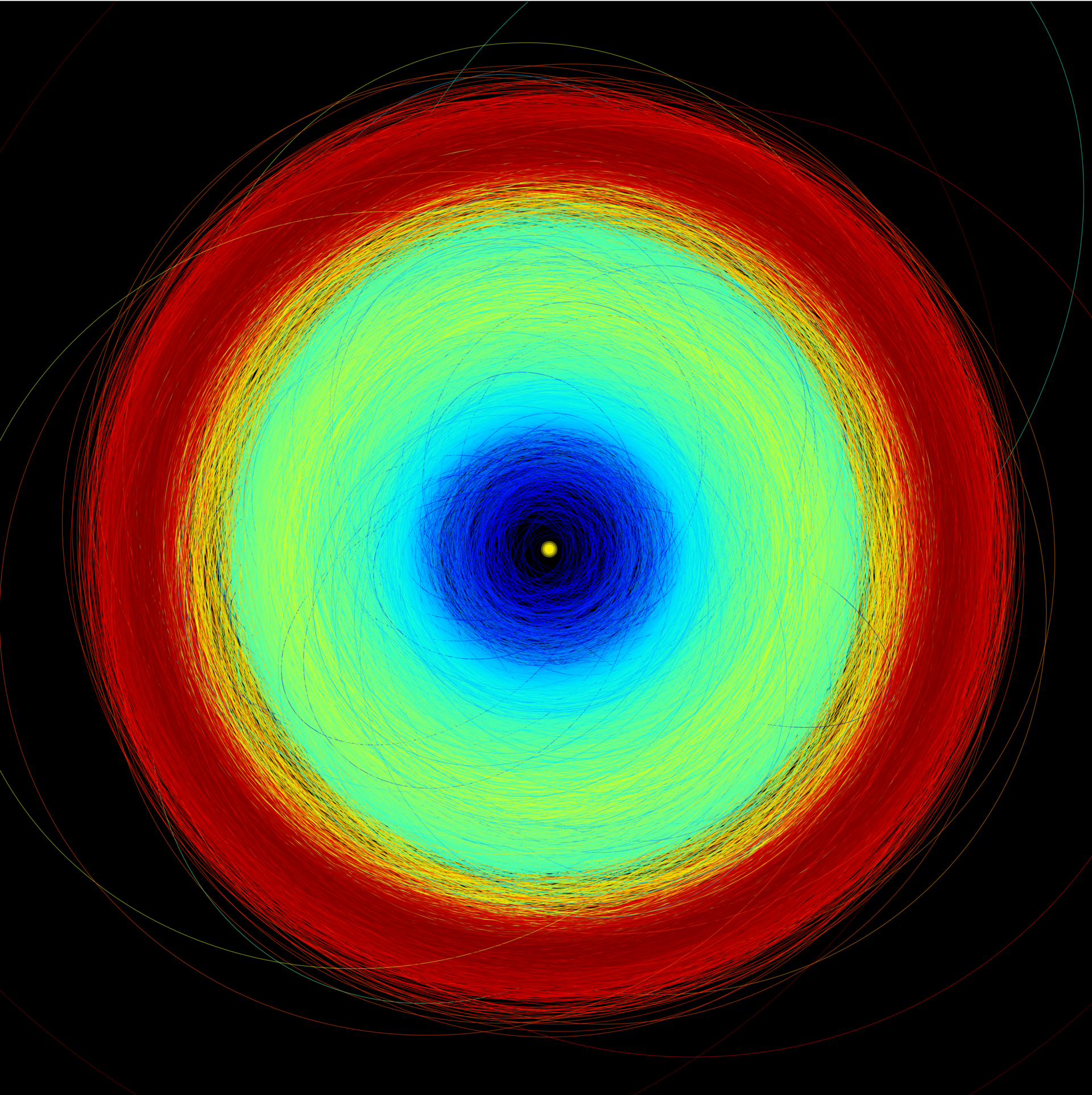Since its launch in 2013 ESA’s Gaia observatory has been mapping our galaxy from Lagrange point 2, creating the most accurate and complete multi-dimensional map of the Milky Way. By now two full sets of data have been released, the first set in 2016 and a second one in 2018. These data releases contained stellar positions, distances, motions across the sky, and colour information, among others. Now on 13 June 2022 a third and new full data set has been released. This data release contains even more and improved information about almost 2 billion stars, Solar System objects and extragalactic sources. It also includes radial velocities for 33 million stars, a five-time increase compared to data release 2. Another novelty in this data set is the largest catalogue yet of binary stars in the Milky Way, which is crucial to understand stellar evolution.
The image below shows the orbits of the more than 154,700 asteroids in Gaia’s data release 3, from the inner parts of the Solar System to the Trojan asteroids at the distance of Jupiter, with different colour codes. The brightest 24 TNOs can also be seen in the attached youtube.
https://dlmultimedia.esa.int/download/public/videos/2022/06/013/2206_013_AR_EN.mp4
The second video shows the huge progress that has been made by measuring ~60 000 reflectance spectra (colour and composition) of Solar System asteroids in Gaia’s data release 3, as compared to 6 000 spectra previously obtained for 4 500 asteroids.
This marks a breakthrough in the analysis of the chemical composition of asteroids, which – together with their orbits – gives precious information about their origin and classification.
The yellow circle at the centre represents the Sun. Blue represents the inner part of the Solar System, where the Near Earth Asteroids, Mars crossers, and terrestrial planets are. The Main Belt, between Mars and Jupter, is green. Jupiter trojans are red.

See also Gaia sees strange stars in most detailed Milky Way survey to date
Astronomers describe strange ‘starquakes’, stellar DNA, asymmetric motions.
https://dlmultimedia.esa.int/download/public/videos/2022/06/008/2206_008_AR_EN.mp4
What’s new in data release 3?
Gaia’s data release 3 contains new and improved details for almost two billion stars in our galaxy. The catalogue includes new information including chemical compositions, stellar temperatures, colours, masses, ages, and the speed at which stars move towards or away from us (radial velocity). Much of this information was revealed by the newly released spectroscopy data, a technique in which the starlight is split into its constituent colours (like a rainbow). The data also includes special subsets of stars, like those that change brightness over time.
In the below image, the top is radial velocity, second is radial velocity and proper motion, third is interstellar dust, bottom is chemical composition,

Gaia sees starquakes in the next video. One of the surprising discoveries coming out of Gaia data release 3, is that Gaia is able to detect starquakes – tiny motions on the surface of a star – that change the shapes of stars, something the observatory was not originally built for.
Previously, Gaia already found radial oscillations that cause stars to swell and shrink periodically, while keeping their spherical shape. But Gaia has now also spotted other vibrations that are more like large-scale tsunamis. These nonradial oscillations change the global shape of a star and are therefore harder to detect.
Nonradial oscillation modes cause a star’s surface to move while it rotates, as shown in the animation. Dark patches are slightly cooler than bright patches, giving rise to periodic changes in the brightness of the star. The frequency of the rotating and pulsating stars was increased 8.6 million times to shift them into the audible range of humans.
https://dlmultimedia.esa.int/download/public/videos/2022/06/009/2206_009_AR_EN.mp4
The following video is about the chemistry of stars in our Milky Way. Stars with higher metallicity are further out from the galactic centre than stars of lower metallicity. Young stars have higher metallicity. You can see that our Sun lies between two spiral arms defined by young stars.
https://dlmultimedia.esa.int/download/public/videos/2022/06/010/2206_010_AR_EN.mp4
Gaia is also revealing information about 10 million variable stars, mysterious macro-molecules between stars, as well as quasars and galaxies beyond our own cosmic neighbourhood.